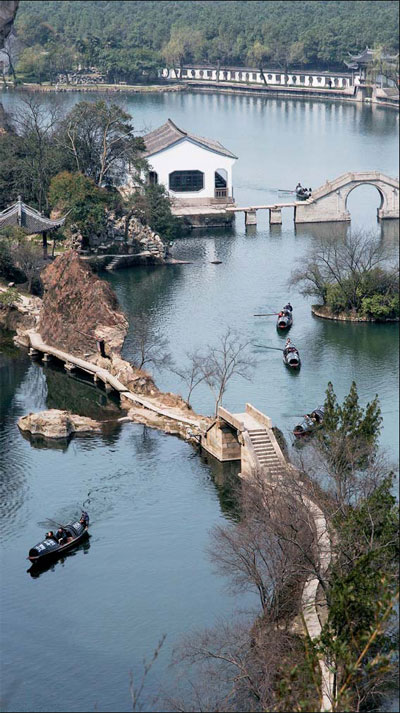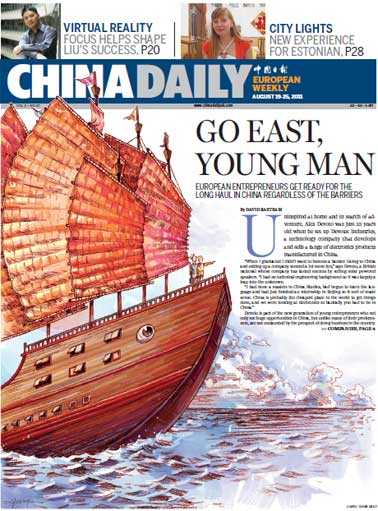Tips and Articles
Venice of china
Updated: 2011-09-23 09:12
By Yin Yin (China Daily)
|
Shaoxing, a tourist destination in East China's Zhejiang province, is an ancient water town surrounded by plenty of rivers. [Provided to China Daily] |
Shaoxing is a perfect holiday spot for those who love the water
Shaoxing is a typical ancient water town where there are many rivers to cross. And a visitor can do so on more than 4,000 stone bridges of various styles and sizes. Abundant waterways and the number of stone bridges are among the most memorable features in this "Venice of China".
Shaoxing has a long history, and it gained recognition during the Spring and Autumn period (770-476 BC) when it acted as the capital of the State of Yue. During the Song Dynasty (960-1279) the authorities named it Shaoxing.
Shaoxing food is famous throughout China, and when local people cook only a little oil is used, making the flavor delicate and light. The main raw materials of Shaoxing food are freshwater fish, shrimps, poultry meat and bean products. Shaoxing chicken is a speciality and prepared by marinating a tender chicken breast in locally made wine.
The following are the five classic attractions in Shaoxing.
1. East Lake
+-

East Lake is basically a 2,000-year-old quarry that was transformed unkowingly by stonemasons into one of China's most picturesque lakes.
This waterway is the No 1 attraction for most visitors to Shaoxing.
The site was used by masons from many dynasties who extracted valuable bluestone, which makes up its bedrock.
Stone builders from the Western Han Dynasty (206 BC-AD24) first used the site but when the Sui Dynasty (AD 581-618) began expanding the Great Wall, the lake really took shape.
The interesting rock formations, rock caves and peaceful surroundings are the highlights of this scenic spot.
Located at the eastern outskirts of Shaoxing, it is one of the three top lakes in Zhejiang province, along with West Lake in Hangzhou and South Lake in Jiaxing.
Visitors can ride in a traditional wupeng boat and enjoy the essense of of this ancient watertown - lovely bridges, flowing water and traditional Chinese architecture built along the riverside.
The wupeng boat is a unique aquatic vehicle, whose name can be attributed to the boat's black cover.
2. Bazi Bridge
Shaoxing is a city of bridges, and there is a famous construction that connects three streets over three waterways.
Because of its distinctive layout, it looks like the Chinese character eight, hence the ba (eight) in its name.
Located downtown, this 800-year old bridge is regarded as one of China's earliest advanced bridges. The 5-meter structure is also a great location so you should lap up the surrounding view.
Locals still live in a very traditional way and most houses were originally built in the Qing Dynasty (1644-1911) and are well kept. Local women wash clothes in the canals beside their houses. Seniors fan coal stoves as they cook, and thin streams of smoke rise into the sky.
3. Keyan Scenic Area
This slice of heaven on earth is famous for its ancient Yue Kingdom culture, integrating the features of Shaoxing waterways, relics of the many dynasties' quarry and rock caves.
Jianhu Lake is a lovely spot where tourists can spend the whole day in touch with nature.
Birdwatchers can see many varieties of of water-birds go about their daily lives in this earthly paradise.
Because of the many water networks, it is home to many species of plants and animals.
The Keyan scenic area is the "green lungs" of Shaoxing, and Jianhu Lake is designated as one of China's National Urban Wetland Parks.
4. Lan Pavilion
Shaoxing has many titles: City of Water, City of Bridges; City of Scholars and City of Tea.
It is also hailed as the City of Calligraphy, and Wang Xizhi is hailed as the saint of this traditional Chinese art form.
His handwriting brings to mind the image of floating clouds or a flying dragon in the sky.
Lan Pavilion is where Wang wrote some of his celebrated calligraphy and has become a sacred site.
Goose Pool is a famous site of Lan Pavilion and is name that because it attracted many geese and still does. Geese were Wang's favorite creatures and featured in many of his works.
5. Former residence of Lu Xun
Lu Xun, the pen name of Zhou Shuren, was a novelist, revolutionist and ideologist of the 20th century.
He spent his teenage years growing up in Shaoxing, which played a backdrop to his stories.
Lu's former residence is a two-story wooden structure built in traditional style and was where he wrote his first novel.
To the east of the residence is the Three Flavor Study, a private school he attended.
In his novels Lu Xun always showed his sympathy to the underclass and described their poverty.
E-paper

Pearl paradise
Dreams of a 'crazy' man turned out to be a real pearler for city
Literary beacon
Venice of china
Up to the mark
Specials

Let them eat cake
Cambridge University graduate develops thriving business selling cupcakes

A case is laid to rest
In 1937, a young woman'S body was found in beijing. paul french went searching for her killer

Banking on change
Leading economist says china must transform its growth model soon

